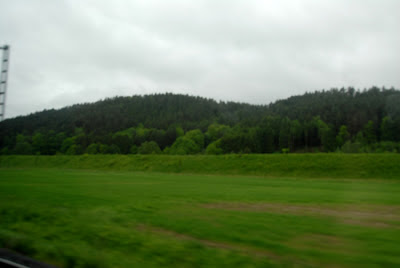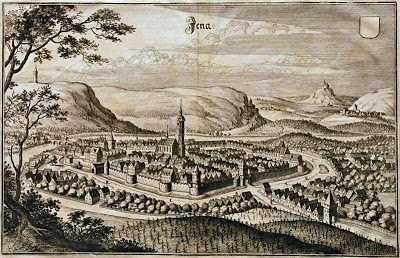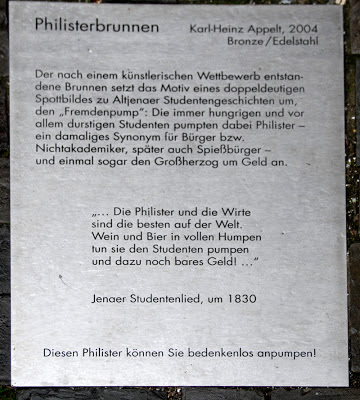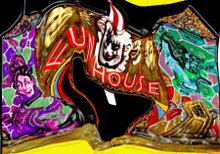Goodbyes and The Trip to Jena
Last days of visits are always sad. The night before we dined in fine style (as we always do in Lichtenfels because of Frau Gareis' wonderful cooking skills. We had roast chicken and a delicious spinach dish as well as Cherry tort.
A neighbor agreed to drive us to the train station. So we left the Zehntweg house and headed on out.
Waving Goodbye at the station is always so stressful, but I don't think anyone has ever gotten a better send-off.
The country-side was lush and green. I wasn't able to capture it well, but there was flooding from all the rain and I was later told that the Saal had greatly over-flowed its banks.
Here is the Kronach station as we passed by.
I took random pictures of the landscape, here are some typical buildings of the Oberfranken area.
We had a very nice modern train car and some of the seats were on platforms so that one could easily see out from a higher level.
Of course not everything was pretty and kept up well. Here was one dilapidated station that we passed by.
On a whim, I decided to get out and see Jena. So many famous Germans had studied and taught there (Fichte, Schlegel, Hegel, Wieland and of course Schiller) and even though I had not read up on the city, I felt it would be worth a look.
It is a beautiful city with lovely architecture.
They had a carnival set up in the town square. I didn't take many pictures of it, but you can see a couple of rides in the picture below.
I think this must have been the Rathaus/townhall originally. I went inside just to look at the building.

Of course the front side has a tower on it!
Anyway there is a wonderful arcade around it.

Of course the front side has a tower on it!
Anyway there is a wonderful arcade around it.
There was some kind of club or meeting inside and I didn't want to disturb anybody, so I looked around quietly and then left.
Here are some of the buildings in the Innenstadt.
In the town square was a statue of John Frederick the Magnanimous who established the University in 1558.
The St Michael's church was prominent in the city, (which was famous for its Lutheran movement).
The original church was connected to a Cistercian monastery (1300s), but what we see here has its origins in 1380 when the City decided to remodel and of course it took a couple hundred years to get the building up and working. If you want to date this structure you could place it between 1450 and 1557.
The church and city suffered great destruction during the second world war, so a lot of this might be reconstruction.
Most famously, it is a church where Martin Luther preached.
Here is his Grabplatte.
There was a prayer service going on - and the accoustics were wonderful when they sang, but of course it made me reluctant to walk around the church too much.
What follows are a couple of pictures of the interior , the organ and pulpit.
This Barock Memorial is lovely.
I walked arounfd the Innestadt a bit and took pictures here and there.
This building had lovely ornament.
Fountains are an opportunity for public art. Here is a roaring lion.)
Who can resist Puti? (My mom can, but I can't!)
Here you can see the venerable University of Jena. (Main building)

Of course I had to walk around the Univesity a bit and seek the spirits of Hegel and Schiller.
I found it amazing the way this door fits together.
This is the interior court yard of the building.
This statue stands before a quote by Bertolt Brecht.
It says, Great Carthage had three wars. After the first one it was still powerful, still inhabitable after the second and not even to be found after the third. Wise words indeed!
Of course to me the next picture really represents the German University!
I'm guessing this might be Fichte below because of his bug eyes and curly hair, but I could be completely wrong. Fichte was dismissed from the University of Jena with charges of being an atheist, because he wrote a book in which he said, "The living and efficaciously acting moral order is itself God. We require no other God, nor can we grasp any other."
This is outside the door of some of the Professors offices. They are full sized. (I'm sure they are copies, but still - how wonderful to be able to take students over to them and really talk about the elements of Greek and Roman sculpture.
A painting on the wall. It could be Goethe and Schiller. They met here for the first time.
This is a view of the street from a window in the University main building.
There was also a small market from which one could buy fruits and vegetables.
This is one of the medieval City gates of Jena called the Johannistor.(Constructed around 1304 and then redone in the Gothic style a hundred years or so later.)
This seems to be a remnant of the original medieval wall. (See the picture below from circa 1650).
And I have no iea what this building is, but I thought it was attractive.
Below you'll see a modern variation on the public fountain. It is called the Phillisterbrunnen - the Philistine fountain. The sign explains that the students loved to take advantage of the bourgeois in Jena and pump them dry of alcohol and money. The sign offers others in Jena the opportunity to pump this particular Phillistine dry of water. (His head is flat and he looks up at the source of the water.)
This deco style building had beautiful sculptural elements.
Here you can see it a bit closer.
And for scale, here is a person nearby.
So then it was time to continue on with my journey. The train was 15 minutes late and so we had to stand out in the wind and the cold and wait, but eventually it showed up and we were off and headed for Weimar.
Here is some grafiti that we saw on the way out.

























































No comments:
Post a Comment